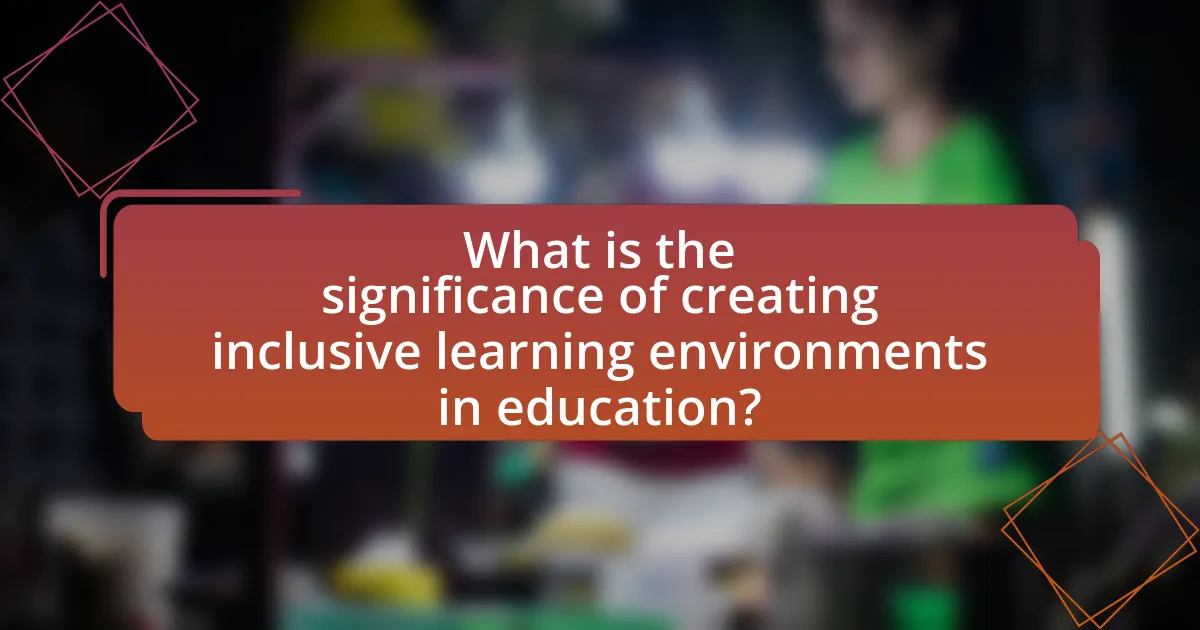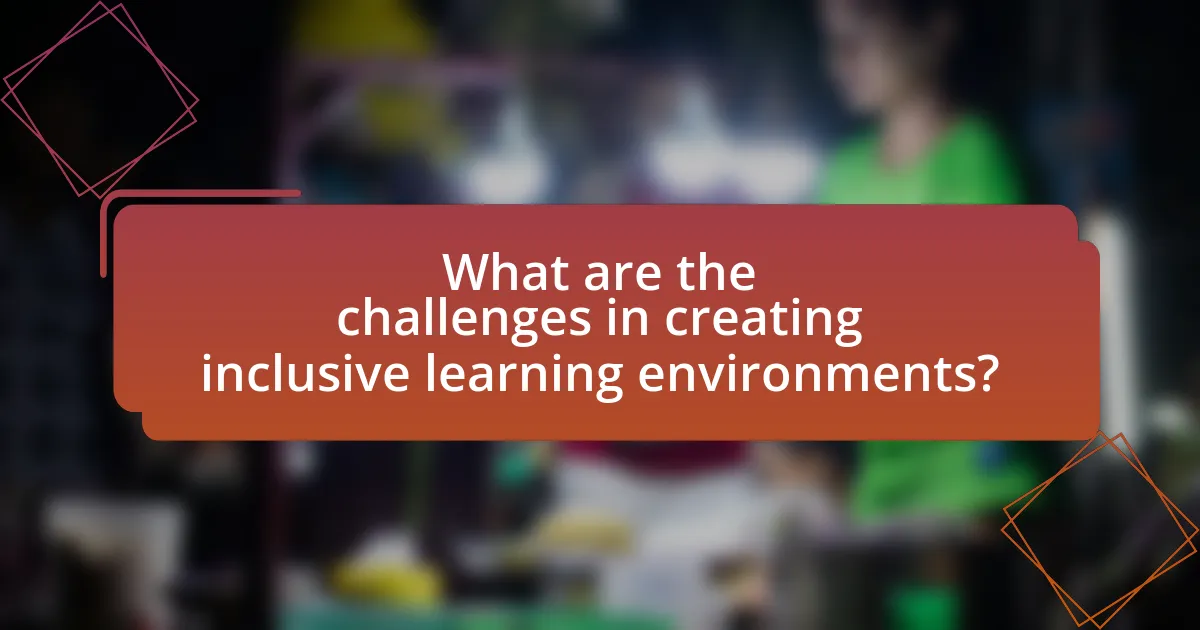Creating inclusive learning environments is essential in education as it promotes equity, enhances student engagement, and improves academic outcomes for all learners. The article explores the significance of inclusivity, highlighting Nelson Mandela’s philosophy that emphasizes equality and the right to education for all individuals. It discusses the benefits of inclusive education, the challenges educators face in implementing it, and the role of policies and community involvement in fostering inclusivity. Additionally, it outlines best practices for creating inclusive classrooms, including differentiated instruction and the use of technology, while providing examples of successful inclusive education policies from around the world.

What is the significance of creating inclusive learning environments in education?
Creating inclusive learning environments in education is significant because they promote equity, enhance student engagement, and improve academic outcomes for all learners. Inclusive environments ensure that diverse student needs are met, fostering a sense of belonging and respect among peers. Research indicates that inclusive classrooms can lead to higher academic achievement; for instance, a study published in the Journal of Special Education found that students with disabilities in inclusive settings performed better academically compared to those in segregated environments. This demonstrates that inclusivity not only benefits marginalized groups but also enriches the educational experience for all students, aligning with Nelson Mandela’s vision of education as a powerful tool for social change.
How does Nelson Mandela’s philosophy influence inclusive education?
Nelson Mandela’s philosophy significantly influences inclusive education by promoting equality, respect for diversity, and the right to education for all individuals, regardless of their background. His belief that education is the most powerful weapon for changing the world underscores the importance of creating learning environments that accommodate diverse needs and perspectives. Mandela’s advocacy for social justice and human rights emphasizes the necessity of dismantling barriers to education, thereby fostering an inclusive approach that values every learner’s potential. His legacy is reflected in policies and practices that aim to ensure equitable access to quality education, which is essential for building a more inclusive society.
What key principles did Mandela advocate for in education?
Nelson Mandela advocated for several key principles in education, emphasizing equality, accessibility, and the importance of education as a tool for social change. He believed that education should be a fundamental right for all individuals, regardless of their background, and that it plays a crucial role in empowering people to overcome oppression and inequality. Mandela famously stated, “Education is the most powerful weapon which you can use to change the world,” highlighting his view that education is essential for personal and societal transformation. His advocacy led to significant reforms in South Africa’s education system, aiming to dismantle the legacy of apartheid and promote inclusive learning environments for all students.
How do Mandela’s beliefs align with the concept of inclusivity?
Nelson Mandela’s beliefs strongly align with the concept of inclusivity through his advocacy for equality and social justice. Mandela emphasized the importance of creating a society where all individuals, regardless of their background, have equal access to opportunities, particularly in education. His famous quote, “Education is the most powerful weapon which you can use to change the world,” underscores his belief that inclusive education is essential for empowering marginalized communities. Furthermore, Mandela’s efforts to dismantle apartheid in South Africa were rooted in the idea that inclusivity fosters unity and progress, as he sought to create a nation where diversity is celebrated and everyone has a voice.
Why is inclusivity important in educational settings?
Inclusivity is important in educational settings because it fosters a sense of belonging and enhances learning outcomes for all students. Research indicates that inclusive environments promote academic achievement, social skills, and emotional well-being. For instance, a study published in the Journal of Special Education found that inclusive classrooms lead to higher academic performance among students with disabilities, as they benefit from diverse perspectives and collaborative learning experiences. Additionally, inclusivity prepares students for a diverse society, equipping them with the skills necessary to engage with individuals from various backgrounds.
What are the benefits of inclusive learning environments for students?
Inclusive learning environments benefit students by promoting diversity, enhancing social skills, and improving academic outcomes. These environments foster a sense of belonging, allowing students from various backgrounds to collaborate and learn from one another. Research indicates that inclusive classrooms lead to higher levels of engagement and motivation, as students feel valued and respected. Additionally, studies show that inclusive education can improve overall academic performance; for instance, a report by the National Center for Learning Disabilities found that students in inclusive settings often outperform their peers in traditional classrooms. This evidence underscores the positive impact of inclusivity on both social and academic development.
How does inclusivity impact educational outcomes?
Inclusivity positively impacts educational outcomes by fostering a supportive learning environment that enhances student engagement and achievement. Research indicates that inclusive classrooms, which accommodate diverse learning needs, lead to improved academic performance and social skills among students. For instance, a study published in the Journal of Special Education found that students in inclusive settings demonstrated higher levels of motivation and participation compared to those in traditional classrooms. This is further supported by data from the National Center for Learning Disabilities, which shows that inclusive education can reduce dropout rates and increase graduation rates, highlighting the long-term benefits of inclusivity in education.

What are the challenges in creating inclusive learning environments?
Creating inclusive learning environments faces several challenges, including diverse learning needs, resource limitations, and societal biases. Diverse learning needs arise from students with varying abilities, backgrounds, and learning styles, making it difficult for educators to address each individual’s requirements effectively. Resource limitations, such as insufficient funding, lack of trained staff, and inadequate materials, hinder the implementation of inclusive practices. Societal biases, including stereotypes and discrimination, can create an unwelcoming atmosphere for marginalized groups, further complicating efforts to foster inclusivity. These challenges collectively impede the development of educational settings that truly accommodate all learners.
What barriers do educators face in implementing inclusivity?
Educators face several barriers in implementing inclusivity, including lack of resources, insufficient training, and systemic biases. Limited funding often restricts access to necessary materials and support services, making it difficult to accommodate diverse learning needs. Additionally, many educators report feeling unprepared to address inclusivity due to inadequate professional development opportunities, which can hinder their ability to create supportive environments. Systemic biases within educational institutions can also perpetuate inequalities, affecting the implementation of inclusive practices. Research indicates that these barriers significantly impact the effectiveness of inclusive education, as highlighted in studies by the National Center for Learning Disabilities, which emphasize the need for comprehensive support systems to foster inclusivity in classrooms.
How can systemic issues hinder inclusive education?
Systemic issues can hinder inclusive education by creating barriers that prevent equitable access to learning opportunities for all students. These barriers include inadequate funding for schools, which limits resources and support services necessary for diverse learners, and rigid curricula that do not accommodate different learning styles or needs. For instance, a study by the National Center for Learning Disabilities found that schools with lower funding often lack specialized staff, such as special education teachers, which directly impacts the ability to provide tailored support for students with disabilities. Additionally, systemic biases within educational policies can perpetuate discrimination against marginalized groups, further isolating them from inclusive practices.
What role does teacher training play in overcoming these barriers?
Teacher training plays a crucial role in overcoming barriers to inclusive education by equipping educators with the necessary skills and knowledge to address diverse learning needs. Effective teacher training programs focus on strategies for differentiation, cultural competence, and the use of assistive technologies, which are essential for creating an inclusive classroom environment. Research indicates that trained teachers are more likely to implement inclusive practices, leading to improved academic outcomes for students with disabilities and those from marginalized backgrounds. For instance, a study published in the “International Journal of Inclusive Education” found that teachers who received specialized training reported higher confidence levels in teaching diverse learners, which directly correlated with increased student engagement and achievement.
How can schools foster an inclusive culture?
Schools can foster an inclusive culture by implementing comprehensive diversity training for staff and students. This training equips individuals with the skills to recognize and address biases, promoting understanding and respect among diverse groups. Research indicates that schools with structured diversity programs see improved student engagement and academic performance, as evidenced by a study from the American Educational Research Association, which found that inclusive practices lead to higher achievement levels for all students. Additionally, schools can create inclusive policies that ensure equitable access to resources and support for students from various backgrounds, further reinforcing a culture of inclusion.
What strategies can educators use to promote inclusivity in the classroom?
Educators can promote inclusivity in the classroom by implementing differentiated instruction, which tailors teaching methods to accommodate diverse learning styles and abilities. This approach allows educators to address the unique needs of each student, fostering an environment where all learners can thrive. Research indicates that differentiated instruction can lead to improved academic outcomes and increased engagement among students from various backgrounds (Tomlinson, 2001). Additionally, incorporating collaborative learning strategies encourages peer interaction and support, further enhancing inclusivity by allowing students to learn from one another.
How can community involvement enhance inclusive education?
Community involvement enhances inclusive education by fostering collaboration between schools, families, and local organizations, which creates a supportive environment for all students. This collaboration leads to the sharing of resources, knowledge, and expertise, enabling schools to better address diverse learning needs. For instance, research from the National Center for Family & Community Connections with Schools indicates that strong family and community engagement can improve student achievement and reduce dropout rates. By actively participating in educational processes, community members can advocate for inclusive practices, ensuring that all students, regardless of their backgrounds or abilities, receive equitable opportunities to succeed.

What are the best practices for creating inclusive learning environments?
The best practices for creating inclusive learning environments include fostering a culture of respect, implementing differentiated instruction, and ensuring accessibility for all students. Fostering a culture of respect involves promoting understanding and appreciation of diverse backgrounds, which can enhance student engagement and collaboration. Implementing differentiated instruction allows educators to tailor teaching methods and materials to meet the varied needs of students, thereby supporting diverse learning styles and abilities. Ensuring accessibility involves providing necessary resources and accommodations, such as assistive technologies and physical access to facilities, which is essential for enabling all students to participate fully in the learning process. These practices are supported by research indicating that inclusive environments lead to improved academic outcomes and social integration for all learners.
How can curriculum design support inclusivity?
Curriculum design can support inclusivity by integrating diverse perspectives and learning styles into educational content. This approach ensures that all students, regardless of their backgrounds or abilities, can engage meaningfully with the material. For instance, incorporating multicultural literature and varied teaching methods, such as visual aids and hands-on activities, caters to different learning preferences and promotes a sense of belonging. Research indicates that inclusive curricula lead to improved academic outcomes and social cohesion among students, as evidenced by studies showing that schools with inclusive practices report higher levels of student engagement and lower dropout rates.
What are the key elements of an inclusive curriculum?
The key elements of an inclusive curriculum include diverse representation, differentiated instruction, accessibility, and collaborative learning. Diverse representation ensures that various cultures, perspectives, and experiences are reflected in the curriculum, promoting a sense of belonging for all students. Differentiated instruction tailors teaching methods and materials to accommodate different learning styles and abilities, allowing each student to engage meaningfully with the content. Accessibility involves providing resources and support that enable all students, including those with disabilities, to participate fully in the learning process. Collaborative learning fosters teamwork and peer interaction, encouraging students to learn from one another and build a supportive community. These elements collectively create an environment where every student can thrive academically and socially.
How can technology be leveraged to enhance inclusivity?
Technology can be leveraged to enhance inclusivity by providing accessible learning tools and resources that cater to diverse needs. For instance, adaptive learning technologies can personalize educational experiences for students with varying abilities, ensuring that all learners can engage with the material effectively. Research indicates that the use of assistive technologies, such as screen readers and speech-to-text software, significantly improves the learning outcomes for students with disabilities, as evidenced by a study published in the Journal of Special Education Technology, which found that 80% of students using these tools reported increased engagement and understanding of the content. Additionally, online platforms can facilitate collaboration among students from different backgrounds, promoting a sense of community and belonging.
What role do policies play in promoting inclusive education?
Policies play a crucial role in promoting inclusive education by establishing frameworks that ensure equitable access to education for all students, regardless of their backgrounds or abilities. These policies set standards for schools to implement inclusive practices, such as differentiated instruction and support services, which are essential for accommodating diverse learning needs. For instance, the United Nations Convention on the Rights of Persons with Disabilities emphasizes the importance of inclusive education, mandating that member states adopt measures to facilitate the inclusion of individuals with disabilities in mainstream educational settings. This legal framework provides a basis for national policies that promote inclusivity, ensuring that educational institutions are held accountable for creating environments that support all learners.
How can educational policies be shaped to support inclusivity?
Educational policies can be shaped to support inclusivity by integrating frameworks that prioritize equitable access to resources and opportunities for all students. This can be achieved through the implementation of universal design for learning (UDL) principles, which advocate for flexible teaching methods that accommodate diverse learning needs. Research indicates that inclusive educational practices lead to improved academic outcomes and social integration, as evidenced by a study published in the “Journal of Special Education” that found schools adopting UDL saw a 20% increase in student engagement and achievement. Additionally, policies should mandate training for educators on cultural competency and differentiated instruction, ensuring that all staff are equipped to meet the varied needs of their students.
What examples of successful inclusive education policies exist globally?
Successful inclusive education policies exist globally, with notable examples including Finland’s comprehensive education system, which emphasizes equal access and support for all students, and Canada’s inclusive education framework that integrates students with disabilities into mainstream classrooms. Finland’s approach has led to high educational outcomes, with 93% of students graduating from upper secondary school, while Canada has implemented policies that promote individualized education plans, resulting in increased participation rates of students with special needs in regular classrooms. These policies demonstrate effective strategies for fostering inclusive learning environments.
What practical steps can educators take to create inclusive learning environments?
Educators can create inclusive learning environments by implementing differentiated instruction, fostering a supportive classroom culture, and utilizing diverse teaching materials. Differentiated instruction allows educators to tailor lessons to meet the varied needs of students, ensuring that all learners can engage with the content effectively. A supportive classroom culture promotes respect and understanding among students, which is essential for inclusivity. Additionally, using diverse teaching materials that reflect various cultures and perspectives helps all students feel represented and valued in the learning process. Research indicates that inclusive practices lead to improved academic outcomes and social skills among students, reinforcing the importance of these steps in educational settings.
How can teachers assess the inclusivity of their classrooms?
Teachers can assess the inclusivity of their classrooms by utilizing a variety of assessment tools and strategies, such as surveys, observations, and feedback from students. These methods allow educators to gather data on student engagement, participation, and the overall classroom environment. For instance, surveys can measure students’ feelings of belonging and acceptance, while observations can help identify whether all students are actively participating in discussions and activities. Research indicates that inclusive classrooms lead to improved academic outcomes and social skills for all students, highlighting the importance of assessing inclusivity to foster a supportive learning environment.
What resources are available for educators to enhance inclusivity?
Educators can enhance inclusivity through various resources such as professional development programs, inclusive teaching materials, and community partnerships. Professional development programs, like those offered by organizations such as the Teaching Tolerance initiative, provide educators with training on culturally responsive teaching and strategies for accommodating diverse learners. Inclusive teaching materials, including differentiated instructional resources and assistive technologies, support varied learning needs and promote engagement among all students. Additionally, partnerships with community organizations can facilitate access to resources and support systems that foster an inclusive environment, as evidenced by studies showing improved student outcomes in schools that actively engage with their communities.



